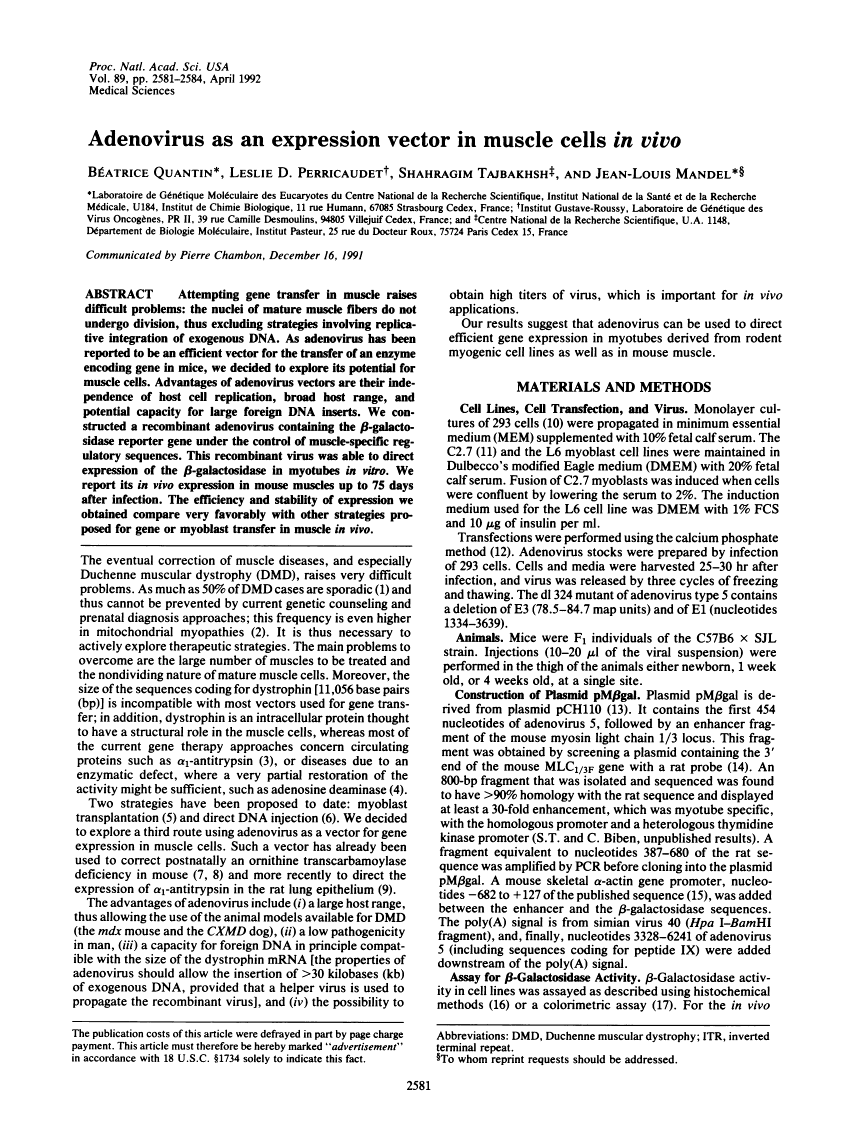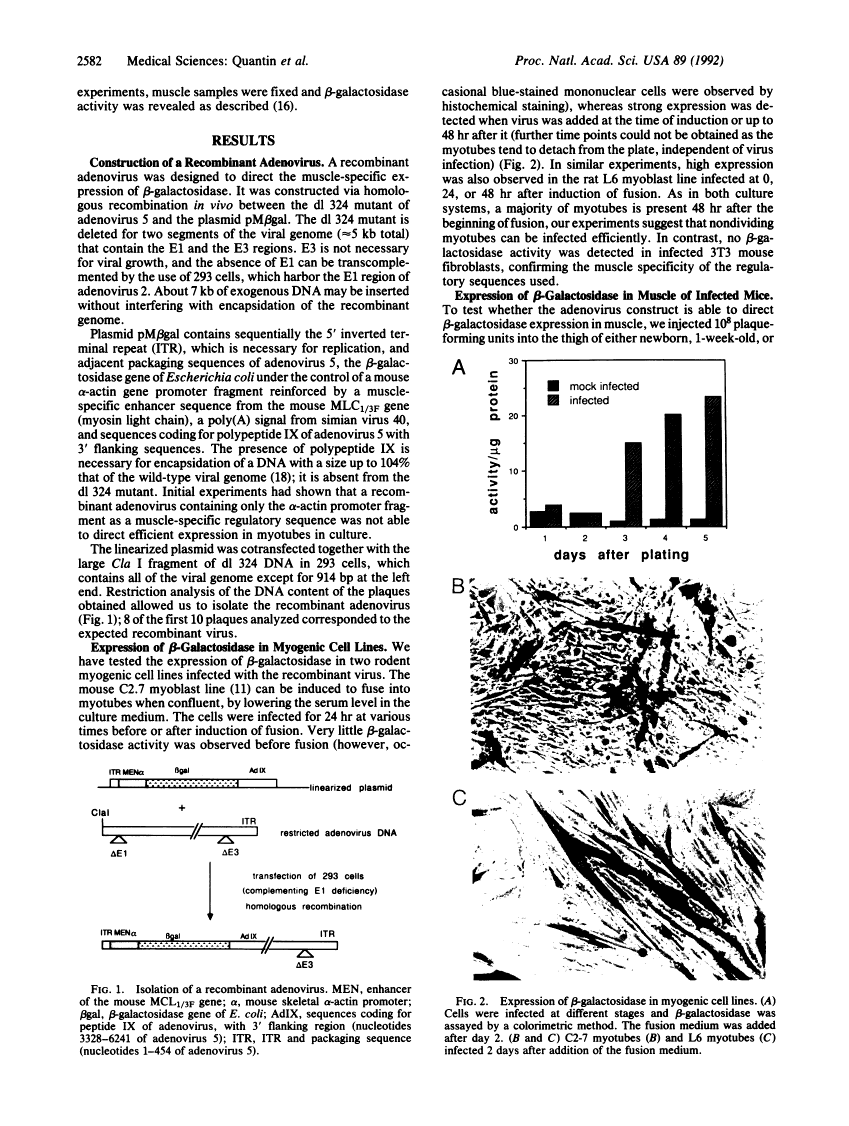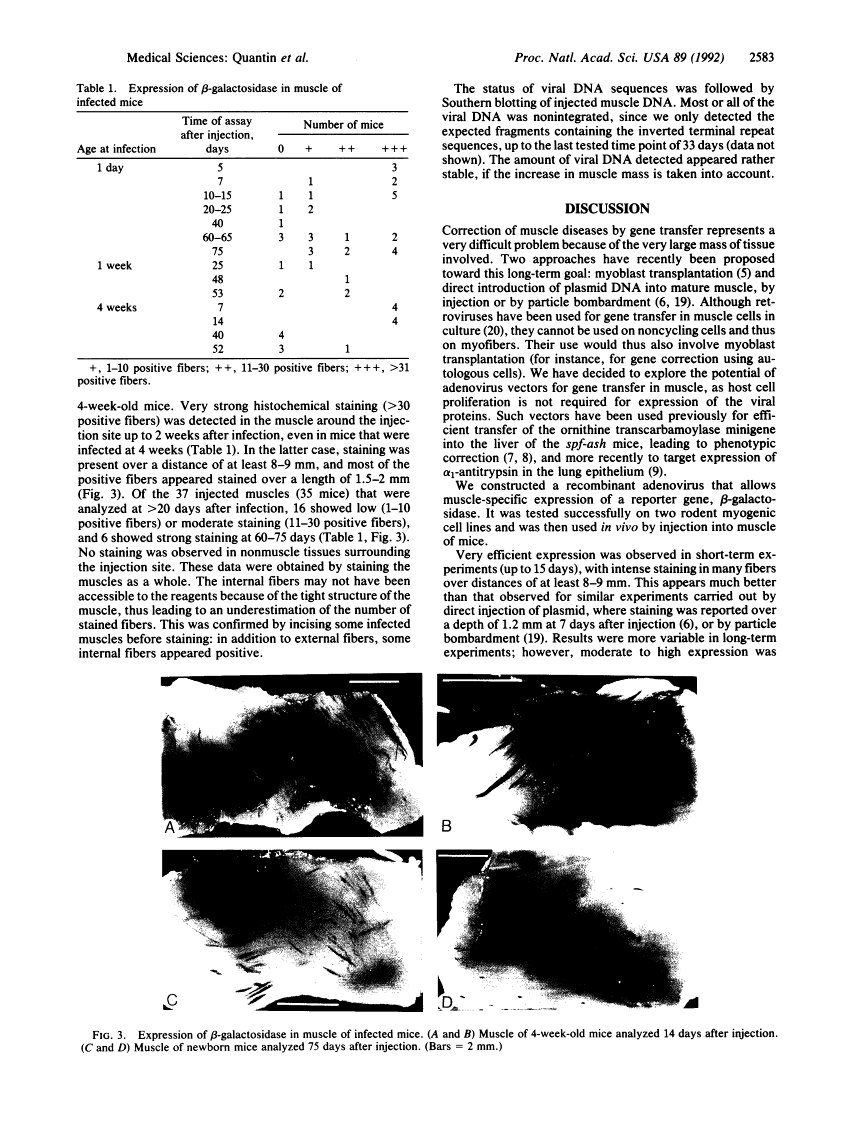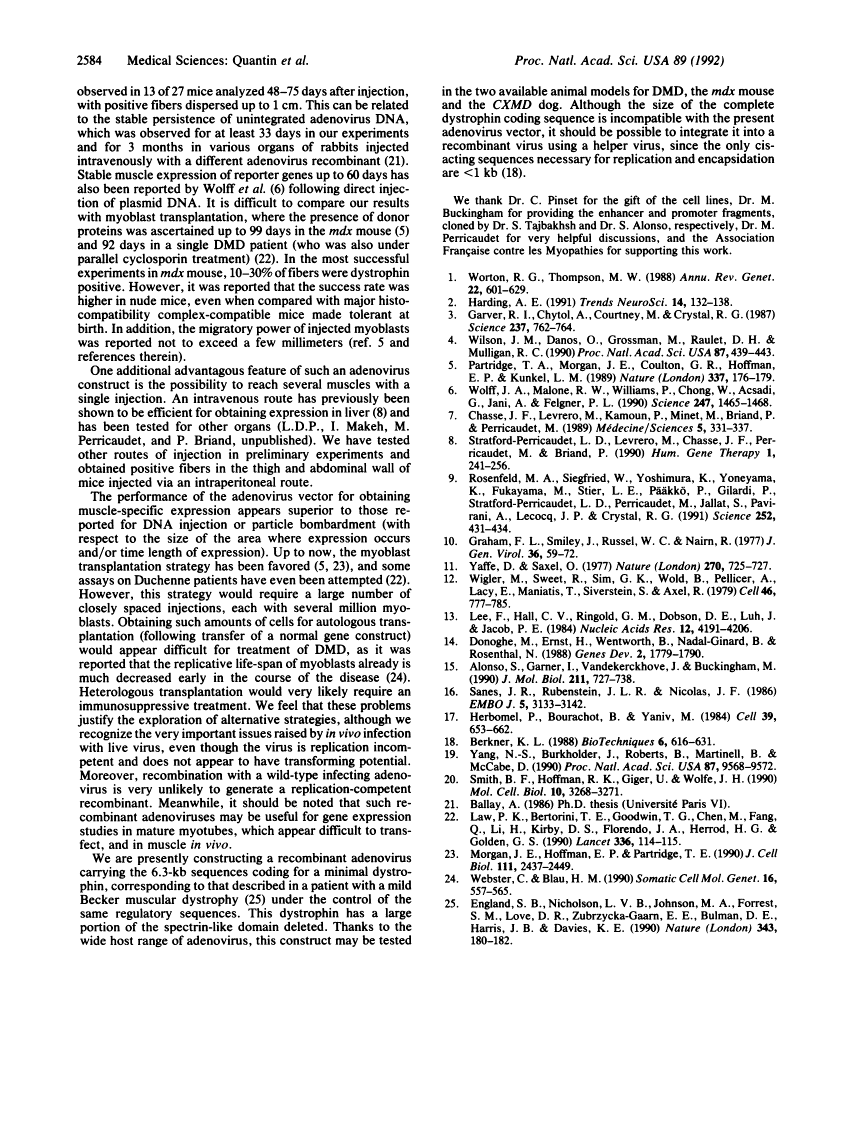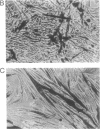Abstract
Free full text

Adenovirus as an expression vector in muscle cells in vivo.
Abstract
Attempting gene transfer in muscle raises difficult problems: the nuclei of mature muscle fibers do not undergo division, thus excluding strategies involving replicative integration of exogenous DNA. As adenovirus has been reported to be an efficient vector for the transfer of an enzyme encoding gene in mice, we decided to explore its potential for muscle cells. Advantages of adenovirus vectors are their independence of host cell replication, broad host range, and potential capacity for large foreign DNA inserts. We constructed a recombinant adenovirus containing the beta-galactosidase reporter gene under the control of muscle-specific regulatory sequences. This recombinant virus was able to direct expression of the beta-galactosidase in myotubes in vitro. We report its in vivo expression in mouse muscles up to 75 days after infection. The efficiency and stability of expression we obtained compare very favorably with other strategies proposed for gene or myoblast transfer in muscle in vivo.
Full text
Full text is available as a scanned copy of the original print version. Get a printable copy (PDF file) of the complete article (1.2M), or click on a page image below to browse page by page. Links to PubMed are also available for Selected References.
Images in this article
Selected References
These references are in PubMed. This may not be the complete list of references from this article.
- Worton RG, Thompson MW. Genetics of Duchenne muscular dystrophy. Annu Rev Genet. 1988;22:601–629. [Abstract] [Google Scholar]
- Harding AE. Neurological disease and mitochondrial genes. Trends Neurosci. 1991 Apr;14(4):132–138. [Abstract] [Google Scholar]
- Garver RI, Jr, Chytil A, Courtney M, Crystal RG. Clonal gene therapy: transplanted mouse fibroblast clones express human alpha 1-antitrypsin gene in vivo. Science. 1987 Aug 14;237(4816):762–764. [Abstract] [Google Scholar]
- Wilson JM, Danos O, Grossman M, Raulet DH, Mulligan RC. Expression of human adenosine deaminase in mice reconstituted with retrovirus-transduced hematopoietic stem cells. Proc Natl Acad Sci U S A. 1990 Jan;87(1):439–443. [Europe PMC free article] [Abstract] [Google Scholar]
- Partridge TA, Morgan JE, Coulton GR, Hoffman EP, Kunkel LM. Conversion of mdx myofibres from dystrophin-negative to -positive by injection of normal myoblasts. Nature. 1989 Jan 12;337(6203):176–179. [Abstract] [Google Scholar]
- Wolff JA, Malone RW, Williams P, Chong W, Acsadi G, Jani A, Felgner PL. Direct gene transfer into mouse muscle in vivo. Science. 1990 Mar 23;247(4949 Pt 1):1465–1468. [Abstract] [Google Scholar]
- Stratford-Perricaudet LD, Levrero M, Chasse JF, Perricaudet M, Briand P. Evaluation of the transfer and expression in mice of an enzyme-encoding gene using a human adenovirus vector. Hum Gene Ther. 1990 Fall;1(3):241–256. [Abstract] [Google Scholar]
- Rosenfeld MA, Siegfried W, Yoshimura K, Yoneyama K, Fukayama M, Stier LE, Päkkö PK, Gilardi P, Stratford-Perricaudet LD, Perricaudet M, et al. Adenovirus-mediated transfer of a recombinant alpha 1-antitrypsin gene to the lung epithelium in vivo. Science. 1991 Apr 19;252(5004):431–434. [Abstract] [Google Scholar]
- Graham FL, Smiley J, Russell WC, Nairn R. Characteristics of a human cell line transformed by DNA from human adenovirus type 5. J Gen Virol. 1977 Jul;36(1):59–74. [Abstract] [Google Scholar]
- Yaffe D, Saxel O. Serial passaging and differentiation of myogenic cells isolated from dystrophic mouse muscle. Nature. 1977 Dec 22;270(5639):725–727. [Abstract] [Google Scholar]
- Wigler M, Sweet R, Sim GK, Wold B, Pellicer A, Lacy E, Maniatis T, Silverstein S, Axel R. Transformation of mammalian cells with genes from procaryotes and eucaryotes. Cell. 1979 Apr;16(4):777–785. [Abstract] [Google Scholar]
- Lee F, Hall CV, Ringold GM, Dobson DE, Luh J, Jacob PE. Functional analysis of the steroid hormone control region of mouse mammary tumor virus. Nucleic Acids Res. 1984 May 25;12(10):4191–4206. [Europe PMC free article] [Abstract] [Google Scholar]
- Donoghue M, Ernst H, Wentworth B, Nadal-Ginard B, Rosenthal N. A muscle-specific enhancer is located at the 3' end of the myosin light-chain 1/3 gene locus. Genes Dev. 1988 Dec;2(12B):1779–1790. [Abstract] [Google Scholar]
- Alonso S, Garner I, Vandekerckhove J, Buckingham M. Genetic analysis of the interaction between cardiac and skeletal actin gene expression in striated muscle of the mouse. J Mol Biol. 1990 Feb 20;211(4):727–738. [Abstract] [Google Scholar]
- Sanes JR, Rubenstein JL, Nicolas JF. Use of a recombinant retrovirus to study post-implantation cell lineage in mouse embryos. EMBO J. 1986 Dec 1;5(12):3133–3142. [Europe PMC free article] [Abstract] [Google Scholar]
- Herbomel P, Bourachot B, Yaniv M. Two distinct enhancers with different cell specificities coexist in the regulatory region of polyoma. Cell. 1984 Dec;39(3 Pt 2):653–662. [Abstract] [Google Scholar]
- Berkner KL. Development of adenovirus vectors for the expression of heterologous genes. Biotechniques. 1988 Jul-Aug;6(7):616–629. [Abstract] [Google Scholar]
- Yang NS, Burkholder J, Roberts B, Martinell B, McCabe D. In vivo and in vitro gene transfer to mammalian somatic cells by particle bombardment. Proc Natl Acad Sci U S A. 1990 Dec;87(24):9568–9572. [Europe PMC free article] [Abstract] [Google Scholar]
- Smith BF, Hoffman RK, Giger U, Wolfe JH. Genes transferred by retroviral vectors into normal and mutant myoblasts in primary cultures are expressed in myotubes. Mol Cell Biol. 1990 Jun;10(6):3268–3271. [Europe PMC free article] [Abstract] [Google Scholar]
- Law PK, Bertorini TE, Goodwin TG, Chen M, Fang QW, Li HJ, Kirby DS, Florendo JA, Herrod HG, Golden GS. Dystrophin production induced by myoblast transfer therapy in Duchenne muscular dystrophy. Lancet. 1990 Jul 14;336(8707):114–115. [Abstract] [Google Scholar]
- Morgan JE, Hoffman EP, Partridge TA. Normal myogenic cells from newborn mice restore normal histology to degenerating muscles of the mdx mouse. J Cell Biol. 1990 Dec;111(6 Pt 1):2437–2449. [Europe PMC free article] [Abstract] [Google Scholar]
- Webster C, Blau HM. Accelerated age-related decline in replicative life-span of Duchenne muscular dystrophy myoblasts: implications for cell and gene therapy. Somat Cell Mol Genet. 1990 Nov;16(6):557–565. [Abstract] [Google Scholar]
- England SB, Nicholson LV, Johnson MA, Forrest SM, Love DR, Zubrzycka-Gaarn EE, Bulman DE, Harris JB, Davies KE. Very mild muscular dystrophy associated with the deletion of 46% of dystrophin. Nature. 1990 Jan 11;343(6254):180–182. [Abstract] [Google Scholar]
Associated Data
Articles from Proceedings of the National Academy of Sciences of the United States of America are provided here courtesy of National Academy of Sciences
Full text links
Read article at publisher's site: https://doi.org/10.1073/pnas.89.7.2581
Read article for free, from open access legal sources, via Unpaywall:
http://www.pnas.org/content/89/7/2581.full.pdf
Citations & impact
Impact metrics
Article citations
Unraveling Muscle Impairment Associated With COVID-19 and the Role of 3D Culture in Its Investigation.
Front Nutr, 9:825629, 10 Feb 2022
Cited by: 13 articles | PMID: 35223956 | PMCID: PMC8867096
Review Free full text in Europe PMC
Emerging Concepts and Challenges in Rheumatoid Arthritis Gene Therapy.
Biomedicines, 8(1):E9, 09 Jan 2020
Cited by: 15 articles | PMID: 31936504 | PMCID: PMC7168286
Review Free full text in Europe PMC
Viral Vector-Mediated Antisense Therapy for Genetic Diseases.
Genes (Basel), 8(2):E51, 26 Jan 2017
Cited by: 10 articles | PMID: 28134780 | PMCID: PMC5333040
Review Free full text in Europe PMC
Co-activator binding protein PIMT mediates TNF-α induced insulin resistance in skeletal muscle via the transcriptional down-regulation of MEF2A and GLUT4.
Sci Rep, 5:15197, 15 Oct 2015
Cited by: 14 articles | PMID: 26468734 | PMCID: PMC4606566
Fatty acid transport protein 1 (FATP1) localizes in mitochondria in mouse skeletal muscle and regulates lipid and ketone body disposal.
PLoS One, 9(5):e98109, 23 May 2014
Cited by: 18 articles | PMID: 24858472 | PMCID: PMC4032244
Go to all (173) article citations
Similar Articles
To arrive at the top five similar articles we use a word-weighted algorithm to compare words from the Title and Abstract of each citation.
Widespread long-term gene transfer to mouse skeletal muscles and heart.
J Clin Invest, 90(2):626-630, 01 Aug 1992
Cited by: 396 articles | PMID: 1644927 | PMCID: PMC443142
Efficient gene transfer into myocardium by direct injection of adenovirus vectors.
Circ Res, 73(6):1202-1207, 01 Dec 1993
Cited by: 122 articles | PMID: 8222091
Heart-specific targeting of beta-galactosidase by the ventricle-specific cardiac myosin light chain 2 promoter using adenovirus vectors.
Hum Gene Ther, 9(13):1919-1928, 01 Sep 1998
Cited by: 20 articles | PMID: 9741430
[Development of adenoviral vectors in gene therapy: application to gene transfer in muscles].
C R Seances Soc Biol Fil, 190(1):13-31, 01 Jan 1996
Cited by: 1 article | PMID: 8881265
Review
